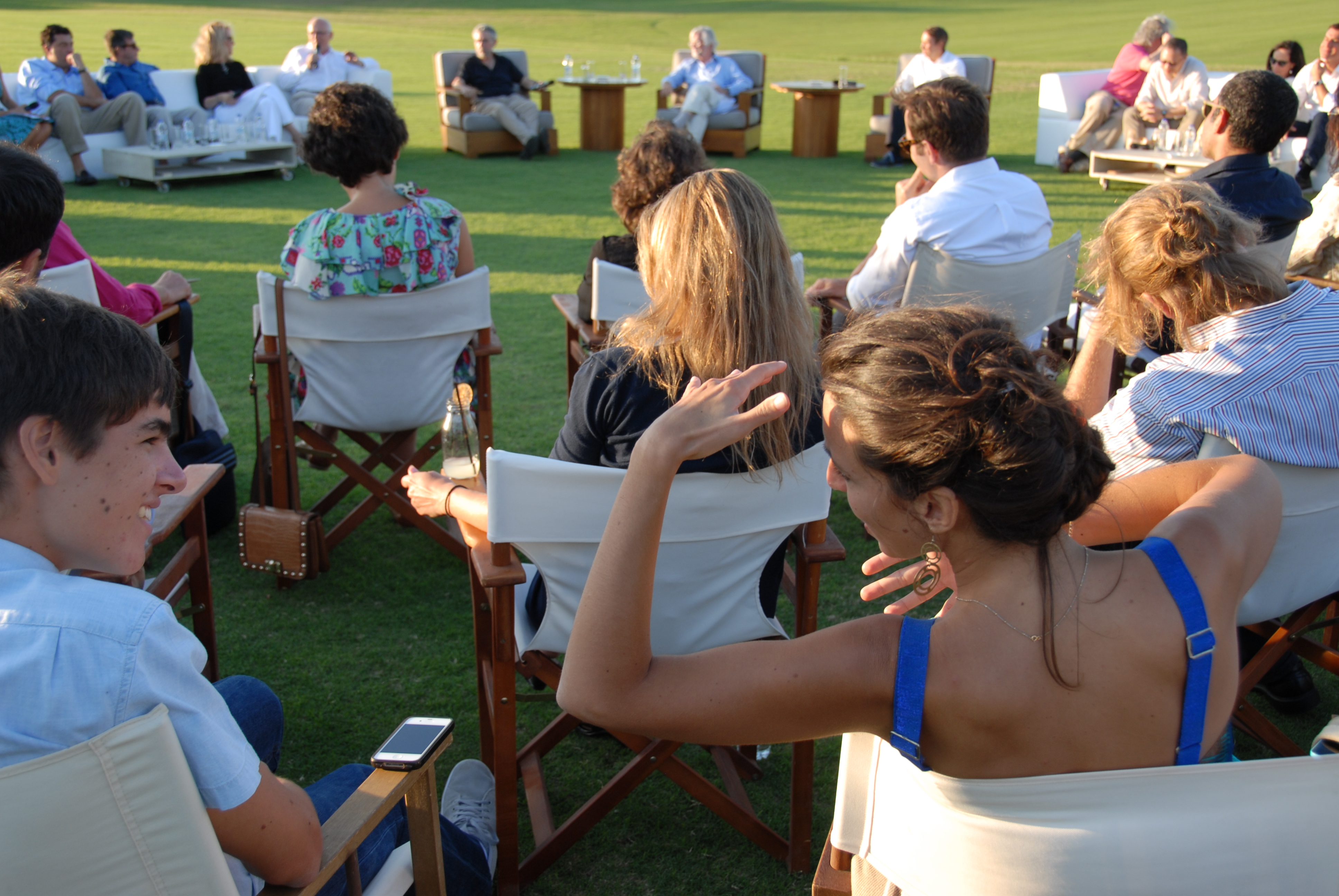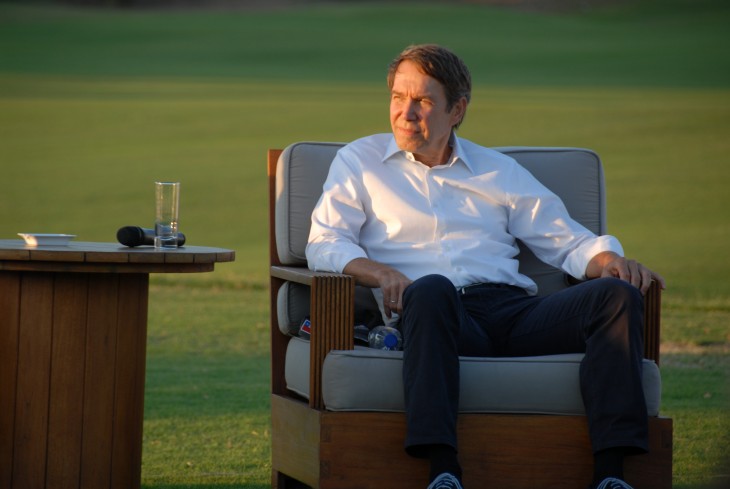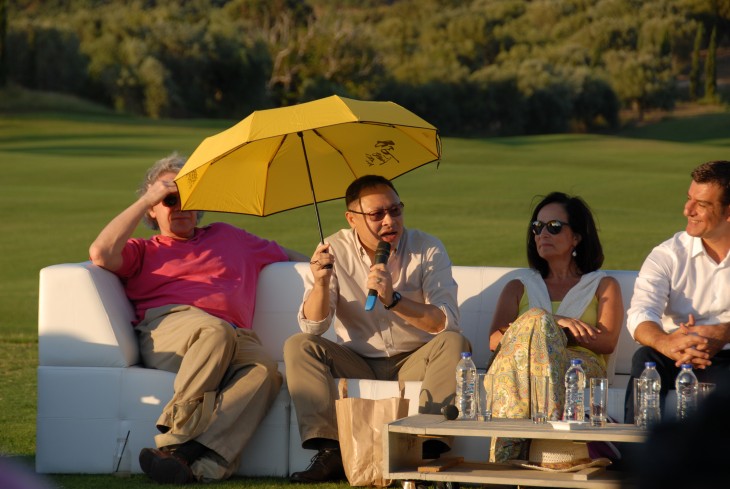HE is sitting there wide-legged in the classic Pelvic Display pose and I can’t take my eyes off – you know what – because one enduring image that I have after researching Jeff Koons is that of his copious equipment beside a vagina. The vagina is that of his former pornstar wife La Cicciolina, and the picture has been exhibited (along with other pornographic photos) in high cultural institutions so I’m guessing it’s OK to mention his balls.
I’d hoped to get an interview with the man said to be possibly the second richest artist in the world next to Damien Hirst. Who knows? It’s all guesstimation. Hirst is said to be worth £400 million but his future worth may be on the wane, although the Times has just reported that New York dealers are buying again. The Game of Koons has probably a few box sets left – he being about at wealthy as the Queen on a bad day.
Back to the forum. His people said ‘no’ to the interview, at least I think they did but you can never be sure the message got anywhere. Koons has hundreds of people attending him, not least the 140 artists that he employs in his art factory in West Chelsea, New York. Mass fabrication explain how he, and Hirst and the Japanese artist Murakami make fortunes. As the original factory artist Andy Warhol said, “being good in business is the most fascinating kind of art”.
The strange thing was that Koons was in Greece as a key speaker at a forum on Art & Democracy, so the fact that he runs a factory seemed worth exploring. Of course it’s not like the satanic mills of Blake’s imagination and Victorian England in the Industrial Revolution, more like the Chocolate Factory of Roald Dahl’s imagination. Like the obsessive owner Willy Wonka , Koons churns out his Technicolor confections from a string of pristine invention rooms manned by his very own Oompa Loompas; in one sealed room they wear protective clothing; in another they sit on mobile scaffolding to reach the top of the canvases they will faithfully paint in according a numbered system.
Will he one day he will hand out Golden Tickets so people can win a guided tour of the factory? If I’d got the chance to do the interview, that’s what I would have asked.
In the factory Koons is said to be ever on the hunt for deviations from his vision. I asked whether he was a something of a tyrant at work, and he agreed: “It’s my creative system and I want it followed as closely as possible” he said, adding in that familiar millionaire modesty of men surrounded by the word “yes” that not many assistants came up with ways he could make the work better.
I’d thought hard about ‘art and democracy’ and what on earth the forum would throw up. It’s a big subject, even the brightest speakers at Costa Navarino on the Peloponnese admitted they found it rather too broad. The only speaker who really had something profound to add was the leader of the Yellow Umbrella movement in Hong Kong, Professor Benny Tai. The protests took the umbrella as a symbol of hope and inspired hundreds of artworks – Tai admitted there were so many he did not even know where they were being stored.
Sadly, the one really pertinent question, namely what great works of art might have brought democracy to a particular society, remained unanswered, although Koons thought that his Tulips sculpture in front of the American Embassy in Beijing, which has been “very popular”, was a “contribution to the community”.
His art is large and very expensive, of course, so it’s easy to say it is undemocratic and helps no-one in particular. Critics hate Koons, on the whole; he has been brutally criticised as the New York Times speaker pointed out. If this was ancient Athens he would probably have been ostracised.
The Times called his work “one last, pathetic gasp of the sort of self-promoting hype and sensationalism that characterized the worst” of the Eighties. Later Robert Hughes wrote that Koons was “an extreme and self-satisfied manifestation of the sanctimony that attaches to big bucks…..with the slimy assurance, the gross patter about transcendence through art, of a blow-dried Baptist selling swamp acres in Florida.”
The public on the other hand, seem to like his art even though they can’t afford so much as a fragment. Perhaps the fact that Koons struck lucky gives them hope that they too may win some sort of career lottery and make it to the top. His giant retrospective, now on its way to the Guggenheim in Bilbao, seems to have provoked no democratic anger, there has been no vandalism – unlike the graffiti which has defaced Anish Kapoor’s Dirty Corner in Versailles or the public protest when Paul McCarthy’s displayed an inflatable green Butt Plug in Paris last year.
Not that this would make much difference. Koons really does not care what people say; he is so completely immersed in himself, so utterly Narcissistic, that he ought to really make a Water and Donald Duck feature as a testament to his impermeable coating of self-love.
The following quote, from Art Forum, seems to sum up Koon’s beauty queen vernacular: “I believe that art has been a vehicle for me that’s been about enlightenment and expanding my own parameters, to give me courage to exercise the freedom that I have in life. Every day I wake up and I really try to pinch myself to take advantage of today and to use that freedom of gesture to do what I really like to do.”
So anyway, coming back to the questions that Koons did not answer because his people said ‘no’, Orchard Times writer and artist Andy Price who assisted me suggested I include the following:
Q. People once believed that art could change the world – is that just an outdated enlightenment idea, a lost sentiment, nostalgia?
Q. What do you think is the greatest global artform that represents humanity at the moment and why?
Q. You are listed as the second richest artist in the world. Where do you think you rank in artistic ability and why?
Q. You have been called a global factory artist, alongside Murakami and Hirst and your art seems to follow the manufacturing lines of Hirst. What are the key differences?
Q. You often use pop icons such as Michael Jackson and the Pink Panther, Popeye. Who are your real heroes?
It is tempting to simply to supply the answers by cutting and pasting parts of the many statements that Koons has made. His rhetoric seamlessly creates a language of gravitas quite at odds with the pulp of his art, statements about a sense of community, about loss of identity, about the freedom to make gestures, about contact with the universal.
With reference to Popeye , for example, he might have expanded on the notion that he told a slightly puzzled-looking Alan Yentob when interviewed for the BBC about his retrospective that what “spinach was to Popeye, so art is to the rest of us: a way of achieving transcendence. ”
I like that, it may be balls or it may be clever and anyway it is useful because you can tell your children that they should eat up their greens if they want to become famous artists and make lots of money, in a democracy of course.
Andrea Watson and Andy Price


